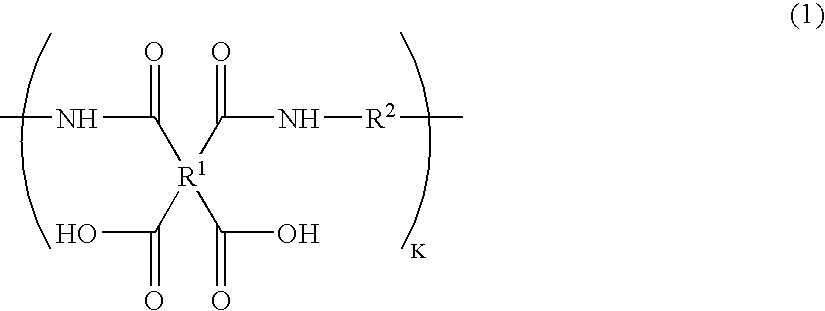Polyamic acid resin composition
a technology of polyamic acid and resin, applied in the direction of instruments, photomechanical devices, photosensitive materials, etc., can solve the problems of insufficient thickness of the ink layer in the vicinity of the bank, and the inability to meet the needs of use,
- Summary
- Abstract
- Description
- Claims
- Application Information
AI Technical Summary
Problems solved by technology
Method used
Image
Examples
example 1
Production of Polyamic Acid Resin Composition
[0066]10.00 g (34.2 mmol) of 1,3-bis(4-aminophenoxy)benzene, 0.44 g (1.8 mmol) of 1,3-bis(3-aminopropyl)-1,1,3,3-tetramethyldisiloxane, and 7.06 g (36.0 mmol) of 1,2,3,4-cyclobutanetetracarboxylic dianhydride were made to react in 96.6 g of N-methylpyrrolidone (hereinafter abbreviated to NMP in some cases) at room temperature for six hours, to obtain a solution of a polyamic acid [a-1] having a number average molecular weight of 40,000 (k=82 as repeating units). The reduced viscosity of the polyamic acid was 1.0 dl / g (in N-methylpyrrolidone at a temperature of 30° C., at a concentration of 0.5 g / dl).
[0067]Furthermore, 1.20 g (4.1 mmol) of 1,3-bis(4-aminophenoxy)benzene, 1.10 g (2.0 mmol) of 4-(4-perfluorooctylphenoxy)-1,3-diaminobenzene, and 1.20 g (6.1 mmol) of 1,2,3,4-cyclobutanetetracarboxylic dianhydride were made to react in 19.8 g of N-methylpyrrolidone (hereinafter abbreviated to NMP) at room temperature for six hours, to obtain a ...
example 2
[0080]0.61 g of the solution of the polyamic acid [b-1] was added into 20 g of the solution of the polyamic acid [a-1] (solid content ratio=97:3), and 5.14 g of NMP was further added thereinto to dilute the solution to a resin concentration of 12%. This solution was stirred at room temperature for one hour to obtain a uniform solution. The mixture obtained was filtered by the 0.4 μm filter to obtain a solution of the polyamic acid resin composition of the present invention.
[0081]Using the solution of the polyamic acid resin composition prepared, a uniform film was formed in a thickness of 2.0 μm in conformity with Example 1. As a result of the same evaluation, the pattern resolution was such that the line-and-space pattern was formed without peeling up to the width of 10 μm. The contact angles of water and methylene iodide determined in conformity with Example 1 were 100° and 73.3°, respectively, and the surface energy was 21.3 dyn / cm.
example 3
[0082]1.41 g (4.8 mmol) of 1,3-bis(4-aminophenoxy)benzene, 3.00 g (5.6 mmol) of 4-(4-perfluorooctylphenoxy)-1,3-diaminobenzene, and 1.86 g (9.5 mmol) of 1,2,3,4-cyclobutanetetracarboxylic dianhydride were made to react in 35.5 g of NMP at room temperature for six hours, thereby obtaining a solution of a polyamic acid [b-2] having a number average molecular weight of 10,000 (l=17 as repeating units). The reduced viscosity of the polyamic acid was 0.4 dl / g (in N-methylpyrrolidone at a temperature of 30° C., at a concentration of 0.5 g / dl).
[0083]0.2 g of the above solution of the polyamic acid [b-2] was added into 20 g of the solution of the polyamic acid [a-1] in Example 1 (solid content ratio=99:1), and 5.0 g of NMP was further added thereinto to dilute the solution to a resin concentration of 12%. This solution was stirred at room temperature for one hour to obtain a uniform solution. The mixture obtained was filtered by the 0.4 μm filter to obtain a solution of the polyamic acid re...
PUM
| Property | Measurement | Unit |
|---|---|---|
| temperature | aaaaa | aaaaa |
| concentration | aaaaa | aaaaa |
| surface energy | aaaaa | aaaaa |
Abstract
Description
Claims
Application Information
 Login to View More
Login to View More - R&D
- Intellectual Property
- Life Sciences
- Materials
- Tech Scout
- Unparalleled Data Quality
- Higher Quality Content
- 60% Fewer Hallucinations
Browse by: Latest US Patents, China's latest patents, Technical Efficacy Thesaurus, Application Domain, Technology Topic, Popular Technical Reports.
© 2025 PatSnap. All rights reserved.Legal|Privacy policy|Modern Slavery Act Transparency Statement|Sitemap|About US| Contact US: help@patsnap.com



